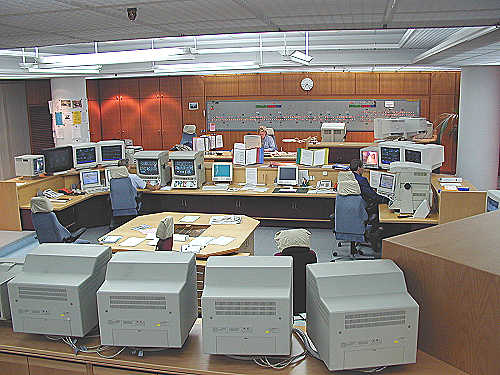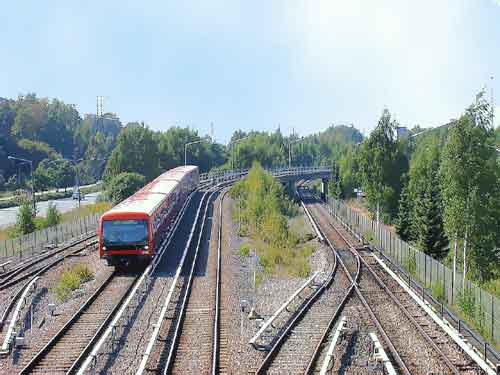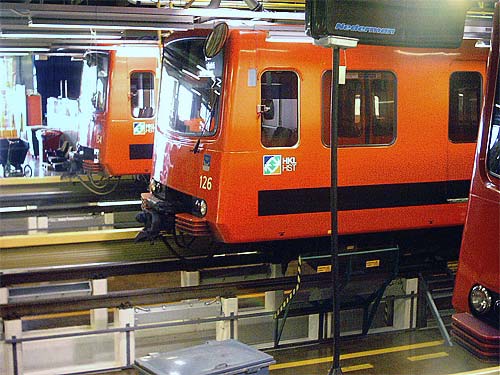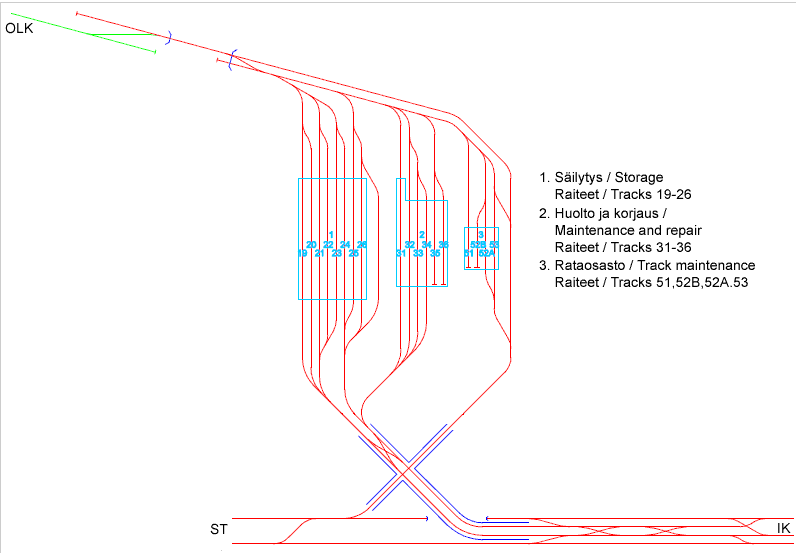Helsingin metron turvalaitteet, liikennöinti ja metrovarikko
Security equipments, traffic and depot:
| Metrojunat voivat olla joko matkustaja-, erikois- tai työjunia. Raideleveys 1524 mm. Sähköistys: tasasähkö 750 V, plusnapa virtakiskossa, miinusnapa kiskoissa. Suurin akselipaino 13 tonnia. Matkustajajunan Sn (suurin sallittu nopeus) 80, työjunan Sn 60. Jos junassa on muita kuin HKL:n vaunuja Sn 35. Kiskoelementtejä kuljettavan työjunan Sn 20. Yli 25 promillen laskuissa työjunan Sn 35. Peruutettaessa junan Sn 10. Ajettaessa ”kuljettajan vastuulla”, jolloin asetinlaite ei pysty varmistamaan kulkutie-ehtojen täydellistä toteutumista ja liikenteenohjaaja asettaa opastimeen poikkeusopasteen (puna-valko), junan Sn 35. Hinattaessa tai työnnettäessä viallista junaa Sn 35. Ajettaessa asemalaiturin ohi pysähtymättä Sn 35, koeajotilanteissa Sn 60. Junan jarrutuskyvyn olennaisesti alennuttua Sn 35. Opastimettomilla turvaamattomilla raiteilla Sn 35. Varikkoalueella Sn 20, paitsi koestusraiteella Sn 80. Koestusraiteen nopeusmittauspisteiden Gü2 ja Gü3 välillä Sn 100. Vaunuhallien sisällä Sn 10. Vaihtotyön Sn 20. Kääntöraiteella Sn 20. Kiskojarrun käyttöä vältettävä silloilla. Käytetään kuitenkin hätätilanteissa. Kulosaaren sillalla saa ajaa vain yksi juna kerrallaan kumpaankin suuntaan. Metroradan on suurin kaltevuus 35 promillea. Paikkoja on kaksi: Hakaniemi – Sörnäinen – tunnelinsuu ja Puotilan tunnelin pohjalta Vuosaaren sillalle noustessa ja päinvastoin. ”Näkyvillä” olevista paikoista jyrkin on Itäkeskuksen syöttöraiteilta metrovarikolle nouseva silta, 25 promillea. Suurin kallistus on Myllypurosta Itäkeskuksen tunneliin mentäessä; oikeanpuoleinen kisko on 16 cm alempana kuin vasen. Paikassa on Itäkeskuksen tulo-opastin (CB). |
The metro trains can be either passenger, special or work trains. Gauge 1524 mm. / 5 ft. Electrification: AC 750 V, positive pole in conductor rail, negative pole in rails. Maximum axle weight 13 tonnes. Sn (maximum allowed speed) 80 for a passenger train, 60 for a work train and 35 if there are other than HKL’s wagons in the train. Sn 20 for a work train delivering rail elements. In descents of more than 25 per mille Sn 35 for work trains. Sn 10 for backing trains. When driving ”at driver’s responsibility” when the switchover monitor can’t ensure a perfect implementation of the traffic way terms and the traffic control person sets an exception signal to the signal (red-and-white), Sn 35 for the train. Sn 35 when towing or shunting a defective train. Sn 35 when passing a station platform without stopping, but Sn 60 in test drive situations. Sn 35 if the train’s stopping power is substantially weakened. Sn 35 at unsecured tracks without signals. Sn 20 in the depot area, however, Sn 80 in the testing track. Sn 100 between the speed measuring points Gü2 and Gü3 of the testing track. SN 10 inside the depot buildings. Sn 20 for switching jobs. SN 20 in turn tracks. The use of track brakes must be avoided on bridges. May be used in emergency situations. The greatest gradient of the metro track is 35 per mille. There are two places: Hakaniemi – Sörnäinen – the tunnel mouth and from the bottom of the Puotila tunnel up to the Vuosaari bridge and vice versa. The steepest of the ”visible” places is the bridge rising from the feeder tracks at Itäkeskus up to the metro depot, 25 per mille. The greatest tilt is at the mouth of the Itäkeskus tunnel when coming from Myllypuro: the right rail is 16 cm lower than the left one. There is the Itäkeskus arrival sign (CB) at the spot. |
Helsingin metroa ja Länsimetroa kehitetään asiakasystävällisemmäksi automatisoimalla junat. Automaattimetro nopeuttaa junien välejä asemilla neljästä minuutista kahteen ja puoleen. Tämän ansiosta metro kykenee kuljettamaan aiempaa enemmän matkustajia, ja heidän odotusaikansa lyhenevät.
Automatisoinnin toteuttaa Siemens. Kyseessä on ensimmäinen kerta, kun automatisointi tehdään olemassa oleviin juniin. Metrolinja ja -varikko automatisoidaan samalla, kun metrojunat jatkavat liikennöintiään normaalisti.
Siemens toimittaa Helsingin metroon automaattisen CBTC-ohjausjärjestelmän (Communication Based Train Control), valvomon, liikenteen turvalaitteet ja junan kommunikaatiojärjestelmät. Näiden lisäksi kauppaan kuuluvat laituriovet ja asemien matkustajainformaatiojärjestelmän näytöt.
Helsingin metro kulkee automaatin ohjaamana näillä näkymin (03.2011) vuonna 2014.
A project to automatise the Metro is also underway. The automation of the Metro became topical when it became evident that the present access control system needed to be renewed. The automation was tendered in 2007. The contract was awarded to Siemens and signed in 2008. The automated Metro will be in operation around 2014. In connection with the automation, platform doors will be installed also at old Metro stations.
Turvalaitteet: Security equipment:
 Valvomot: Control rooms:
Valvomot: Control rooms:
Kuva: Hakaniemen keskusvalvomo. Kuvassa liikennetyönjohtaja yläpöydässä ja kaksi liikenteenohjaajaa alhaalla.
Kuva © HKL-Metroliikenne.
Picture: the Hakaniemi central control room. A traffic supervisor at the upper table and two traffic control persons below.
Picture © HKL-Metroliikenne.
| Hakaniemen keskusvalvomosta hoidetaan keskitetty liikenteen, asemien ja sähkönsyötön valvonta sekä miehittämättömien Herttoniemen, Kontulan ja Vuosaaren aluevalvomoiden liikennevalvonta kaukokäytön avulla. Keskitetty liikenteenohjausjärjestelmä (käytönohjausjärjestelmä) koostuu tietokonelaitteistosta, jolla automatisoidaan liikenteenohjauksen jatkuvasti toistuvat rutiinitoiminnot. Käytönohjausjärjestelmä mahdollistaa reaaliaikaisen matkustajainformaation. Järjestelmään kuuluvalla kaukokäyttölaitteistolla keskitetään turvalaitteiden ohjaukset siten, että aluevalvomoissa ei tarvita miehitystä. Helsingin metron turvalaitteet ovat modulaarisia ja niiden toiminta on pitkälle automatisoitua, jolloin liikenteenohjaajien toimenpiteet rajoittuvat minimiin liikenteen ollessa normaalia Turvalaitteet valvovat metroasemien suoja- ja savuovia. Metrovarikon säilytyshallien ovien automaattinen valvonta on myös liitetty turvalaitteiden piiriin. Metron turvalaitteiden tehtävänä on taata liikenteen turvallisuus mm. estämällä inhimillisen erehdyksen vaikutukset. Turvalaitteet käsittävät ns. asetinlaitteet, junien pakkopysäytyslaitteet ja nopeudenvalvontalaitteet. Asetinlaitteiden (Hakaniemi, Herttoniemi, Kontula, Vuosaari, Metrovarikko) avulla käännetään ja lukitaan vaihteet oikeaan asentoon. Näin varmistetaan kulkutiet. Asetinlaitteilla myös varmistetaan, että kulkutie on vapaa, pidetään junat turvallisella etäisyydellä toisistaan ja näytetään ajoa ohjaavat opasteet kuljettajalle. Pakkopysäytyslaitteet, joihin kuuluu kiskojen välissä oleva magneetti, junassa ensimmäisen akselin edessä oleva antenni ja ohjaamossa oleva pakkojarrulaitteen käyttöpaneeli. Magneetti on aktiivisena kun opastin näyttää ”seis” tai ”poikkeusopaste”, tai nopeudenvalvontapiste (katso alla) havaitsee ylinopeuden. Magneetit ovat pääopastimen kohdalla ja hieman nopeudenvalvontapisteen jälkeen. Pakkojarrulaite ei estä ajamasta seis – opasteen ohi, mutta se pysäyttää junan kulkutiehen kuuluvalle ohiajovaralle punaista päin ajettaessa. Radassa olevat magneetit eivät ole pistemäisen kulunvalvonnan antureita (vertaa VR), vaan raidevirtapiirit toimivat junan ilmaisijoina asetinlaitteelle, joka ”tietää” junan sijainnin 50 – 500 metrin tarkkuudella paikasta riippuen. Nopeudenvalvontalaitteet valvovat junien nopeutta paikoissa, joissa junaturvallisuus edellyttää tätä. |
The Hakaniemi central control room takes care of the centralised control of traffic, stations and electricity transmission as well as the traffic control for the unmanned area control rooms of Herttoniemi, Kontula and Vuosaari by remote control. The centralised traffic control system (operation control system) consists of a computer apparatus which automatizes the frequently repeated routine operations of the traffic control. The operation control system makes real-time passenger information possible. The remote control of the system centralises the control of the safety devices so that the are control rooms need not be manned. The safety devices of the Helsinki metro are modular and their functions are highly automatized. Therefore, when traffic is normal, the actions of the traffic control persons are restricted to a minimum. The safety devices control the prohibited and smoke doors of the stations. Even the automatic control of the doors of the metro depot repository buildings is connected to the safety devices.The function of the metro safety devices is to ensure traffic safety by a.o. preventing the consequences of human error. The safety devices include the switchover monitors, the forced stopping equipment of the trains and the speed control equipment. The switchover monitors (Hakaniemi, Herttoniemi, Kontula, Vuosaari and the metro depot) are used for shifting and point locking of the switches in the right position. Thus the traffic ways are ensured. The switchover monitors also ensure a free traffic way and a safe distance between the trains and show the driving signals to the driver. The forced stopping equipment consists of a magnet between the rails, an antenna in front of the first front axle of the train and a control panel of the forced braking device in the driver’s cabin. The magnet is active when the signal shows ”stop” or ”exception signal” or a speed control point (see below) detects overspeed. The magnets are situated with the primary signals and shortly after speed control points. The forced braking device doesn’t prevent from driving pass the stop sign but it stops the train within the pass-drive reserve of the traffic way when driving against a red light. The magnets in the track are not point formed traffic control sensors (as with VR) but the track circuits detect the trains for the switchover monitor that ”knows” the train’s location with a 50 – 500 metre accuracy depending on the place. The speed control devices control the speed of the trains in places where train safety requires such action. |
| Metrolla on Siemensin toimittama turvatekniikka ja induktioon perustuva kulunvalvonta. Magneetteja on kolmenlaisessa paikassa: pääopastimen kohdalla, 10-20m nopeudenvalvontapisteen jälkeen ja kääntöraiteen päässä ennen raidepuskinta (= 20m ennen kallioseinää). Eli magneetin pystyy periaatteessa ohittamaan vaikka nopeudella 80 km/h ilman, että mikään puuttuu asiaan aiemmin. Juuri tämän vuoksi kulkutiehen kuuluu riittävä ohiajovara, pois lukien kääntöraide ja kytkentäkulkutie. Ohiajovaraa on enimmillään noin 400 metriä, mutta pakkojarru pysäyttää junan täydestä vauhdista poikkeuksetta 100-150m matkalle. Jokainen ohiajovara on laskettu juuri sille paikalle sopivaksi erityisten kaavojen mukaan, jossa huomioidaan käytettävä nopeus, radan profiili yms. Opastimen ja vaihteen etäisyys toisistaan riippuu paikasta ja vaihteen Sn:stä. Lyhimmillään vaihde on 5 metrin päässä opastimesta ja pisimmillään 400 metriä. Ajonopeutta itse vaihteen kohdalla ei valvota. Kelta-vihreän (Sn35) pääopastimen voi periaatteessa ohittaa millä vauhdilla tahansa. Vain kuljettaja on päättämässä nopeudesta. Metrojunan painopiste on kuitenkin sellainen, ettei se suistu kiskoilta max. nopeudellakaan. Penkillä pysyminen matkustamon puolella saattaa kuitenkin olla hankalaa. Vuosaaren ja Mellunmäen (pääteasemia) tulo-opastimen jälkeen, 350 metriä ennen Sn35-vaihdetta, on kuitenkin nopeudenvalvontapiste. Kaksi peräkkäistä anturia mittaa ylikulkuajan ja aktivoi parinkymmenen metrin päässä olevan pakkojarrumagneetin jos nopeus on liian suuri. Junaan tulee pakkojarru ja se pysähtyy ennen vaihdetta. Jos kulkutie on tulovaihteessa suorille (1-raiteelle/laituriin), valvotaan nopeutta 60km/h. Nopeudenvalvontapisteitä on linjalla viisi ja varikon kilometrin pituisella koestusraiteella neljä. Uusissa M200-junissa on ”musta laatikko” josta ajotiedot voidaan kaivaa tarvittaessa esiin.Sn 60 sallivia vaihteita (poikkeavassa raiteessa) on Itäkeskuksen itäpäässä tunnelissa 4kpl, Hakaniemen ja Kaisaniemen välillä 1 molemmin puolin, Rautatieaseman ja Kampin välillä 1+1 sekä Kampin länsipäässä molemmilla raiteilla 1kpl. Kääntyväkärkiset sn 35 -vaihteet ovat vain Rastilan länsipuolella L1, L2, H1 ja H2 -tunnuksilla olevat vaihteet. Pistemäinen kulunvalvonta: Linjaraiteella ja osin varikolla on ns. pakkojarrumagneetit pääopastimien kohdalla. Opastimen näyttäessä seis-opastetta (tai poikkeusopastetta) on ratamagneetti aktiivinen. Junan ohjaamon alla oleva antenni tunnistaa yliajettaessa magneetin ja laukaisee pakkojarrutuksen (levyjarrut+kiskojarrut). Juna ei kuitenkaan pysähdy opastimen taakse, vaan turvatulle kulkutien osalle, ohiajovaralle. Ohiajovaran pituus riippuu rataosan nopeusrajoituksesta, ja on pisimmillään 300-400 metriä. Seis-opasteen ja poikkeusopasteen voi ohittaa erityisellä ohitustoiminnolla. Ohiajovaraa on enimmillään ~400 metriä, mutta pakkojarru pysäyttää junan täydestä vauhdista poikkeuksetta 100-150m matkalle. |
The metro has a security technique by Siemens and a passage control based on induction. The magnets are situated in three different kinds of places: in connection to the primary signal, 10-20 metres after a speed control point and at the end of a turn track before the rail barrier (= 20 metres before the rock wall). A magnet can thus in principle be passed at 80 km/h without anything preventing it before that. Exactly why a traffic way includes an adequate pass-drive reserve, excluding a turn track and a coupling traffic way. The pass-drive reserve is about 400 metres at the most, but the forced braking device stops the train from full speed without exception within 100-150 metres. Each pass-drive reserve has been calculated for the exact spot according to special formulae noting the used speed, the track profile etc. The distance between the switch and the signal depends on the place and the Sn of the switch. At the shortest, the switch is located 5 metres from the signal and at the longest, 400 metres. The driving speed at the switch is not controlled. A yellow-green (Sn35) primary signal can in principle be passed at any speed. Only the driver decides over the speed. The centroid of a metro train is, however, such that the train will not derail even at maximum speed. Staying on the seat in the passenger cabin might still be difficult. After the arrival signals of the Vuosaari and Mellunmäki end stations, 350 metres before an Sn35 switch, there is, however, a speed control point. Two consecutive sensors measure the crossing time and activate the forced braking magnet situated some 20 metres ahead if the speed is too high. The train will then start forced braking and stop before the switch. If the traffic way in the arrival switch leads to direct rails (track 1/platform), the speed controlled is 60 km/h. There are five speed control points at the route and four in the 1 km long testing track in the depot area. The new M200 trains are equipped with a ”black box” that can be used to confirm driving data if necessary. Switches allowing Sn 60 (deflecting tracks): four in the tunnel at the east end of Itäkeskus, one at each side between Hakaniemi and Kaisaniemi, 1+1 between Central Railway Station and Kamppi and one at both tracks at the west end of Kamppi. Switches with turning switch points (Sn 35) only exist to the west from Rastila, bearing signs L1, L2, H1 and H2. Point formed passage control: On the route track and partly in the depot there is a forced braking magnet in connection with each primary signal. When the signal is showing ”stop” or ”exception”, the track magnet is active. The antenna underneath the driver cabin’s floor recognises the magnet when crossing and launches a forced braking (disk brakes and track brakes). The train does not stop behind the signal but on a secured part of the traffic way, the pass-drive reserve. The length of the pass-drive reserve depends of the speed limit of the track section and is 300-400 metres at the most. A ”stop” signal and an ”exception” signal can be passed using a special passing function. The pass-drive reserve is ca 400 metres at the most but the forced braking will stop the train from full speed without exception within 100-150 metres. |
Metrovarikko / The metro depot
 M200 -sarjan nelivaunuinen juna saapumassa varikolta Itäkeskuksen syöttöraiteistolle.
M200 -sarjan nelivaunuinen juna saapumassa varikolta Itäkeskuksen syöttöraiteistolle.
A four-car M200 train arriving from the depot to the feeder track at Itäkeskus.
 Metrovarikon huoltohalli.
Metrovarikon huoltohalli.
Kuvat 29.8.2002 © Eero Laaksonen
Hallissa hoidetaan päivittäiset tarkastukset ja määräaikaishuollot.
Varikolla tehdään tietysti tarvittaessa korjauksia ja muutostöitä.
The maintenance hall of the metro depot. Pictures 29.8.2002 © Eero Laaksonen
Daily inspections and fixed-period maintenance are performed in the hall.
Of course, the depot performs repairs and changes when necessary.
 Elokuussa 2003 HKL ja Talgo sopivat 39 metrojunan peruskorjauksen suorittamisesta. Metrovaunut kuljetetaan rekkakuljetuksena Helsingin ja Otanmäen välillä.
Elokuussa 2003 HKL ja Talgo sopivat 39 metrojunan peruskorjauksen suorittamisesta. Metrovaunut kuljetetaan rekkakuljetuksena Helsingin ja Otanmäen välillä.
In August 2003, HKL and Talgo agreed over the renovation of 39 metro trains. The trains are transported on lorries between Helsinki and Otanmäki.
| Rakennukset: – Rataosaston halli, valmistunut 1971, laajennettu 1990? Aiemmin koejunien huoltohalli. – Keskusrakennus, valmistunut 1980 – Huoltohalli, valmistunut 1980 – Säilytyshalli, valmistunut 1981Varikolla on junien huoltopaikkoja 6 ja korjauspaikkoja 8. Säilytyshallissa on huoltopaikkoja 4 ja säilytyspaikkoja 44.Huoltohallin läpimenevillä raiteilla suoritetaan määräaikaishuollot. Muut huoltohallin raiteet on varattu pitempiaikaisia huoltoja ja korjauksia varten. Säilytyshallissa pidetään vähintään +5 °C lämpötila, jotta kalusto olisi talviolosuhteissakin aina käyttövalmiina. Varikon sisäistä liikennettä ohjataan varikon asetinlaitteella valvomosta. Varikolta johtaa kaksi raidetta itään (Itäkeskukseen) ja yksi länteen (Siilitien aseman suuntaan). Tunnelin kautta on raideyhteys metron yhdysradalle (Oulunkylään). Varikon sisäinen osa tästä yhteydestä toimii testaus- ja koestusraiteena. |
Buildings: -Hall of track department, completed in 1971, expanded in 1990? Previously maintenance hall for the test trains. – Central building, completed in 1980 – Maintenance hall, completed in 1980 – Repository hall, completed in 1981 At the depot, there are 6 maintenance spots and 8 repair spots for the trains. In the repository, there are 4 maintenance spots and 44 repository spots. Fixed-period maintenance is performed on the drive-through tracks in the maintenance hall. Other tracks in the maintenance hall are reserved for more time consuming maintenance and repairs. The temperature in the repository hall is kept at a minimum of +5 centigrade so that the trains would be ready for use even in the wintertime. Two tracks lead to the east of the depot (to Itäkeskus) and one to the west (towards Siilitie station). Through the tunnel, there is a connection to the metro connecting track (to Oulunkylä). The depot part of this connection functions as a testing track. |
Varikon raidekaavio / Depot track diagram

Varikko / Depot 2008. © Jaakko Pertilä
Metrolinja ja raidekaavio 2020 (pdf)
© Jaakko Pertilä

